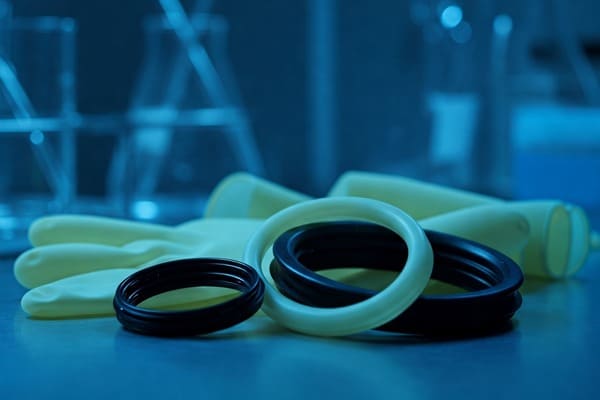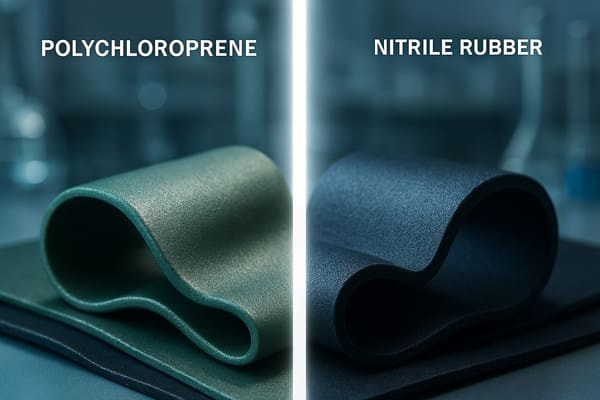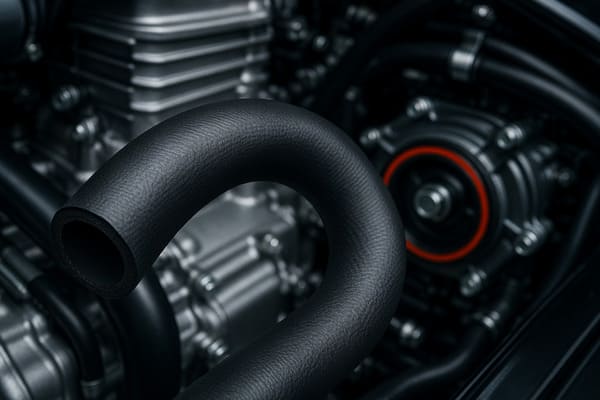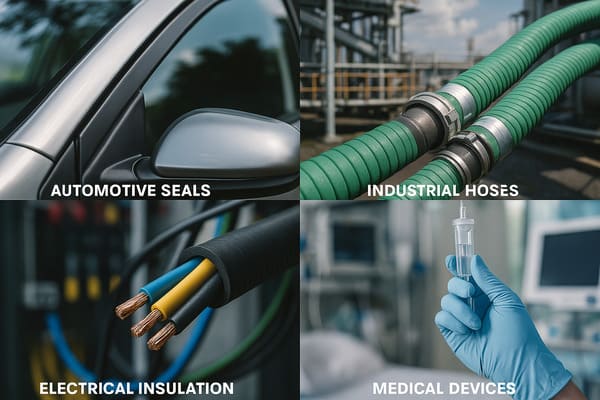Polychloroprene, commonly known as chloroprene rubber or CR, is a versatile synthetic rubber widely used in various industries for its unique properties. Let’s dive into the characteristics, production process, and applications of this material.
Polychloroprene is a synthetic rubber made from chloroprene monomer, known for its excellent resistance to oil, heat, and weathering, making it ideal for automotive, industrial, and medical applications.

Polychloroprene stands out in the world of synthetic rubbers for its impressive durability and versatility. Let’s explore how it is produced, its key characteristics, and where it excels compared to other types of rubber.
What Is Polychloroprene Made Of?
To understand the properties of polychloroprene, it’s important to look at how it is made. This synthetic rubber is derived from the polymerization of chloroprene monomer.
Polychloroprene is produced through the polymerization of chloroprene, a chlorinated derivative of isoprene, which gives it its distinct properties, such as resistance to heat, oil, and environmental factors.
Polychloroprene is synthesized from chloroprene, a chemical compound that is a chlorinated form of isoprene. The polymerization process involves combining chloroprene monomers in the presence of initiators and solvents, under controlled conditions of temperature and pressure. The resulting polymer, polychloroprene1, is a highly flexible and durable synthetic rubber2 that can be further modified to enhance specific properties depending on the intended application.
The key properties of polychloroprene come from its molecular structure, which includes alternating double bonds along the polymer chain, making it resistant to degradation and highly elastic. This molecular structure also allows polychloroprene to be vulcanized, improving its heat and aging resistance.
| Component | Role in Polychloroprene Production |
|---|---|
| Chloroprene Monomer | The building block of polychloroprene |
| Initiators | Trigger polymerization |
| Solvents | Aid in polymerization and process control |
What Is the History of Polychloroprene?
The development of polychloroprene has a rich history, marked by significant advancements in synthetic rubber technology. Let’s take a look at how polychloroprene came to be.
Polychloroprene was first synthesized in the 1930s by the French chemist Julien P. W. C. G. Oelkers, leading to the commercial development of Neoprene in the 1930s by DuPont.
Polychloroprene was first synthesized in the late 1920s by French chemist Julien Oelkers. However, it wasn’t until the 1930s that DuPont commercialized it under the trade name Neoprene3. Polychloroprene quickly became popular due to its excellent resistance to oils, heat, and weathering, which made it ideal for a wide range of industrial applications, including seals, gaskets, and hoses.
Since then, polychloroprene has undergone several modifications and improvements, including the development of different grades with enhanced chemical resistance and flexibility. Today, it is widely used across many industries and continues to be an essential material for automotive, industrial, and medical applications.
| Year | Event |
|---|---|
| 1920s | Synthesis of polychloroprene |
| 1930s | DuPont commercializes Neoprene |
| 1950s and beyond | Development of various grades and improvements |
Is Polychloroprene a Nitrile?
Polychloroprene and nitrile are both synthetic rubbers, but they have different chemical compositions and properties. Let’s clarify the difference between them.
No, polychloroprene is not nitrile. While both are synthetic rubbers, nitrile rubber (NBR) is primarily made from acrylonitrile and butadiene, whereas polychloroprene is made from chloroprene monomers.

Although both polychloroprene and nitrile rubber are synthetic elastomers, they are derived from different monomers, which leads to distinct differences in their properties:
Polychloroprene (CR) is made from chloroprene and is known for its excellent resistance to oils, heat, weather, and ozone. It is commonly used in automotive, industrial, and medical applications.
Nitrile Rubber4 (NBR), on the other hand, is made from the copolymerization of acrylonitrile and butadiene. It is primarily used in applications where oil and fuel resistance is critical, such as seals, gaskets, and fuel system components.
| Property | Polychloroprene (CR) | Nitrile Rubber (NBR) |
|---|---|---|
| Chemical Composition | Chloroprene | Acrylonitrile and Butadiene |
| Oil Resistance5 | Excellent | Excellent |
| Temperature Resistance | Moderate (up to 120°C) | High (up to 120°C) |
| Applications | Automotive, industrial, medical | Automotive, fuel, industrial |
What Is the Trade Name for Polychloroprene?
Polychloroprene is sold under various trade names by different manufacturers. Let’s explore some of the most well-known brands of polychloroprene.
One of the most popular trade names for polychloroprene is Neoprene, which is produced by companies like DuPont. Other manufacturers may use different names, depending on the specific formulation.
Polychloroprene is often sold under the brand name Neoprene, which is a trademark of DuPont. Neoprene is one of the most well-known types of polychloroprene and is widely used in applications requiring oil resistance, flexibility, and heat stability.
Other manufacturers may produce their own formulations of polychloroprene under different trade names, and these products may vary in terms of specific additives, performance properties, and intended uses.
| Brand Name | Manufacturer | Applications |
|---|---|---|
| Neoprene | DuPont | Automotive, medical, industrial |
| Baypren | Bayer | Automotive, industrial, HVAC |
| Chloroprene Rubber | Various Producers | Gaskets, seals, industrial parts |
Properties of Polychloroprene
Polychloroprene offers a unique combination of properties that make it suitable for demanding applications. Let’s explore the key features that set this material apart from other rubbers.
Polychloroprene is known for its excellent resistance to oil, heat, UV light, and weathering, making it ideal for automotive, industrial, and outdoor applications.

Polychloroprene’s excellent performance in various challenging environments is due to its distinct properties:
Oil and Fuel Resistance: Polychloroprene has excellent resistance to oils, fuels, and solvents, making it ideal for automotive and industrial applications where contact with such chemicals is common.
Heat and Aging Resistance: Polychloroprene maintains its flexibility and strength at higher temperatures, and its chemical structure ensures it resists degradation over time, even under exposure to heat and UV radiation.
Weather and Ozone Resistance: One of the standout features of polychloroprene is its resistance to ozone and weathering. It performs well in outdoor applications and environments with fluctuating weather conditions.
Flexibility and Elasticity: Similar to other synthetic rubbers, polychloroprene is highly flexible and elastic, which makes it suitable for gaskets, seals, and coatings that need to withstand repeated stress.
| Property | Polychloroprene (CR) | Other Rubbers |
|---|---|---|
| Oil and Fuel Resistance | Excellent | Varies |
| Heat Resistance | High (up to 120°C) | Varies |
| Ozone and Weather Resistance | High | Varies |
| Flexibility | Good | Varies |
Applications of Polychloroprene
Polychloroprene is used in a wide range of applications due to its durability and resistance to various environmental factors. Let’s explore the most common uses of polychloroprene.
Polychloroprene is widely used in automotive seals, industrial hoses, electrical insulation, and medical devices due to its strength, flexibility, and chemical resistance.

Polychloroprene’s unique properties make it ideal for several critical applications, including:
Automotive: Polychloroprene is commonly used in automotive seals, gaskets, and belts due to its resistance to oils, heat, and weather. It is also used in fuel system components because of its excellent fuel resistance.
Industrial: In industrial settings, polychloroprene is used for hoses, belts, and rubber parts that come into contact with chemicals, oils, and heat. Its weather-resistant properties also make it suitable for outdoor applications, such as in machinery exposed to the elements.
Electrical: Polychloroprene is often used as an insulating material in cables and electrical components, thanks to its excellent dielectric properties and resistance to heat and aging.
Medical: In medical applications, polychloroprene is used in gloves, medical tubing, and other devices where flexibility, durability, and chemical resistance are required. Its non-toxic nature makes it safe for use in healthcare settings.
| Industry | Application | Benefit of Polychloroprene (CR) |
|---|---|---|
| Automotive | Seals, gaskets, fuel system components | Heat, oil, and weather resistance |
| Industrial | Hoses, belts, machinery parts | Durability, chemical resistance |
| Electrical | Cable insulation, electrical components | Heat resistance, dielectric properties |
| Medical | Gloves, medical tubing | Flexibility, chemical resistance |
Conclusion
Polychloroprene is a highly versatile synthetic rubber with outstanding properties, including resistance to heat, oils, UV light, and weathering. With its broad range of applications in industries such as automotive, medical, and industrial, it continues to be an essential material. Understanding its history, trade names, and differences from other rubbers like nitrile can help you choose the best material for your needs.
🚀 Need Custom Polychloroprene Solutions for Your Industry?
Contact Julong Rubber today or Request a Custom Quote for high-quality polychloroprene products tailored to your needs!
Explore the diverse applications of polychloroprene to understand its significance in automotive, medical, and industrial sectors. ↩
Discover the advantages of synthetic rubber, including polychloroprene, over natural rubber in various applications. ↩
Learn about Neoprene, a popular trade name for polychloroprene, and its various applications across industries. ↩
Discover the advantages and specific applications of Nitrile Rubber, especially in oil and fuel resistance. ↩
Learn about the oil resistance capabilities of various rubber types, crucial for selecting the right material for your needs. ↩






